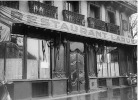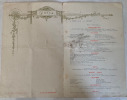Restaurant Larue - Paris.
Nignon's Menu July 9th 1913.
310 x 200 mm. 2 leaves, 4 pages. Very colourful front cover with an elegantly dressed lady and man entering the restaurant with the Maitre d' in attendance. The inside 2 pages: the first one blank and the second with a very comprehensive a'la Carte menu. The back cover ornate printer's device with E.Nignon's initials. On the third page a light smudge not affecting the menu text. Overall a unique item housed in a handsome marbled folder.
- - This extensive a' la Carte menu from the Restaurant Larue, surprises with its elegance, but most of all because it is laid out very similarly to the menus of Claridges Hotel in London. Nignon was the Chef du Cuisine there from 1894 - 1901. One wonders if the format was started by him then. When I was the Chef Poissonier there in the 1980's, it still had the same a' la Carte menu format. Edouard Nignon (1865-1934), widely regarded within the industry as one of the greatest French chefs. During his career, he cooked at the Cafe Anglais, the Paillard, L'Ermitage in Moscow and directed a brigade of 120 chefs at the Moscow Metropole Hotel. He was at different times according to the Larousse Gastronomique, head chef to the Tsar, the Emperor of Austria, and President Woodrow Wilson. Finally finishing his career at his own "Restaurant Larue'. Situated at the corner of Rue Royale and Place de la Madeleine, and opened by Nignon in 1908. Recognized by the members of the French Academy and other Chefs as one of the fathers of modern French cuisine. Michel Guérard, himself one of the founders of nouvelle cuisine, described Nignon as a visionary chef who had a huge influence on French cooks such as himself and Joël Robuchon. Nignon remains to this day relatively unknown to the general public. He received in his dining room "Tout Paris".(meaning 'Everyone in Paris', a French expression referring to the fashionable and affluent elite of the city, who frequent fashionable events and places, and establish trends in upper-class culture). He was a star in monarchist, bonapartist, nationalist and aristocratic circles. In 1922 aged 57 years old, Nignon was hospitalized to undergo the removal of a kidney and health problems dogged him till his death. His nephew Célestin Duplat, also married to a niece of Madame Nignon, directed the kitchens as Head of Cuisiniers. Nignon said about him "He was at my side in Moscow and other important houses so that I can testify to his professional knowledge. With Célestin at the helm, the establishment is in good hands". In 1933, one year before Nignon dies. his beloved Larue is finally honored with three Michelin stars and will keep them until the war. After the second world war, the restaurant is not able to revive its pre-war grandeur. Larue and its famous wine cave were sold. (Image #2 below), shows the restaurant Larue near Place de la Madeleine, closed before being sold, in Paris in 1954. In the NY Times archive, an article by Jane Nickerson describing the closing of Larue in 1954, in particular the auction in May 11th, of its famous wine cellar. The briskest bidding was for the cognacs bearing the Larue name. A Fine Champagne Cognac of 1795 was sold for $46.oo. ($445.oo in 2021). Two famous brandies were the 1858 Cognac Maison Larue and the 1845 Armagnac Restaurant Larue (see image #6 below). An elderly woman who refused to be identified bought 542 bottles of red burgundy. They included Clos de Vouget 1923, Vosne Romanee 1945, and an estate-bottled Corton 1947. This was the final chapter in the life a great chef and his famous restaurant.






click on image to enlarge

Ephemera category
ref number:
10934